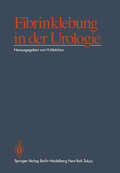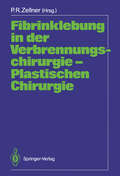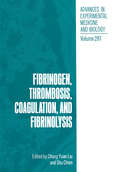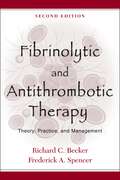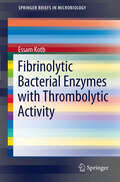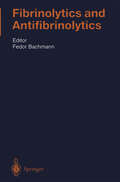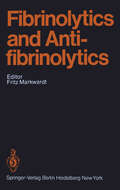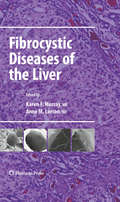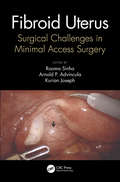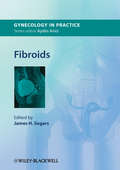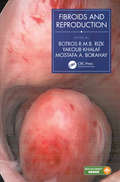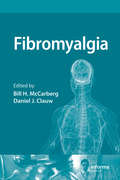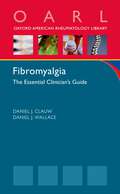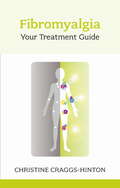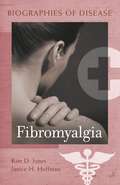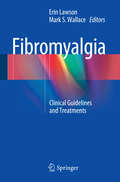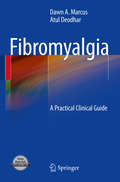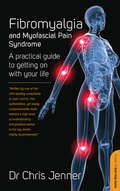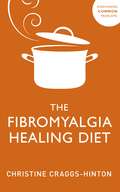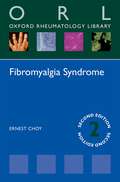- Table View
- List View
Fibrinklebung in der Verbrennungschirurgie — Plastischen Chirurgie
by Peter R. ZellnerDie Fibrinklebung ist zur lokalen Hämostase und zur Wundversorgung in vielen operativen Disziplinen zu einem Routineverfahren geworden. Das vorliegende Buch enthält die Beiträge eines Symposiums, das sich speziell mit Indikation, Technik und den Ergebnissen dieser Methode aufgrund experimenteller und klinischer Untersuchungen in der Plastischen Chirurgie und Verbrennungschirurgie beschäftigte. Neue Indikationen, wie z.B. in der Tumorchirurgie und ästhetischen Chirurgie werden diskutiert. Jeder operativ tätige Arzt erhält damit eine umfassende, aktuelle und kritische Orientierung über Möglichkeiten, Grenzen und Kosten-Nutzen-Analyse dieser neuen operativen Technik.
Fibrinogen, Thrombosis, Coagulation, and Fibrinolysis (Advances in Experimental Medicine and Biology #281)
by Chung Yuan Liu S. ChienThe International Scientific Symposium on Fibrinogen, Thrombosis, Coagulation, and Fibrinolysis was held in Academia Sinica, Taipei, Taiwan, Republic of China, on August 30 - September 1, 1989. This Symposium has provided a forum for the free exchange of information in this important and rapidly advancing research field. This proceedings volume provides a published record of 46 papers presented at the Symposium. The sponsors have exerted no influence on the scientific opinions or positions of the participants in the Symposium. It is hoped that this Symposium will stimulate further worldwide cooperation and collaboration in these vital fields for the benefit of all human kind. This volume is composed of four parts. The first part consists of 8 papers on Fibrinogen and Fibrin: Biochemistry, Molecular Biology, and Physiology. The second part contains 16 papers on Coagulation and Fibrinolysis: Biochemistry, Molecular Biology, and Physiology. The third part has 10 papers on Cardiovascular Cell Biology: Biochemistry, Molecular Biology, and Physiology. The fourth part comprises 12 papers on Clinical Studies of the Cardiovascular System: Thrombotic and Bleeding Disorders and Thrombolytic Therapy. The Author Index with addresses of all contributors and the Subject Index of all 46 papers are arranged at the end of this volume.
Fibrinolytic and Antithrombotic Therapy: Theory, Practice, and Management
by Richard C. Becker Frederick A. SpencerThrombotic disorders of the circulatory system represent the leading cause of morbidity, motality, and health care expenditure in the United States. Fibrinolytic and Antithrombotic Therapy provides a practical, evidence-based approach to the management of thrombotic disorders for all clinicians involved in the care of patients with these disorders. It provides not only vital conceptual information on fibrinolytic and antithrombotic therapy, but also the means to apply it to everyday decision making and patient care. Focusing on managment guidelines and critical pathways, the text stresses practicality and usability. It will be a valuable resource for the wide range of clinicians involved in the care of patients with these disorders, including cardiologists, emergency physicians, primary care physicians, hematologists, neurologists, intensivists, pharmacists, and nurse practitioners. The origins of mammalian blood coagulation can be traced back over 400 million years. Despite its long history, it is only within the past century that this complex and pivotal teleologic system has begun to be understood. Most recently, the intricacies of hemostasis and pahtologic thrombosis have come to light, leading the way toward new, more effective, and safer treatment modalities. The Second Edition of Fibrinolytic and Antithrombotic Therapy, even more concise and clinically relevant than the First, provides vital, evidence-based information on management of patients with arterial and venous thrombotic disorders. Since the First Edition, the text has been expanded to cover the evolving topics of atherothrombosis, thrombocardiology, hematologic/thrombophilic conditions, and vascular medicine. It includes up-to-date guidelines for antithrombotic and fibrinolytic therapy, and offers concise summaries of current "standards of care." Chapters are dedicated to discussions of patient-specific therapeutics and to the importance of genomics, proteomics, and metabolomics in defining genotype-phenotype relationships, while throughout the book coagulation, inflammation, and vascular medicine are newly examined as elements in an intricatley-linked triad of biochemical and cellular based phenomenology.
Fibrinolytic Bacterial Enzymes with Thrombolytic Activity (SpringerBriefs in Microbiology)
by Essam KotbStress, high blood pressure, smoking, pollution, fast foods, overweight, excessive travelling, surgery, less movement are common features in our modern life. These features are risky for blood clotting disorders. According to WHO, over 29% of the total mortalities worldwide are due to thrombosis. By the year, 2020 cardiovascular diseases (CVDs) may cause an estimated 25 million deaths per year, thus antithrombotic therapy is of great interest. The available thrombolytic agents such as urokinase are highly expensive, antigenic, quite unspecific, pyretogenic and hemorrhagenic. Therefore, the production of fibrinolysing enzymes, which rapidly dissolute thrombi within the vascular tree, without the detriments by microorganisms, as described in this book, is the desirable aim of today’s research.
Fibrinolytics and Antifibrinolytics (Handbook of Experimental Pharmacology #146)
by F. BachmannWith contributions by numerous experts
Fibrinolytics and Antifibrinolytics (Handbook of Experimental Pharmacology #46)
by B. Blombäck P. C. Comp P. D. Desnoyers F. Duckert U. Hedner K.N.v. Kaulla H. P. Klöcking M. Kopec H. Landmann Z. B. Latallo F. Markwardt I. M. Nilsson M. Pandolfi K. C. Robbins W. E. Roschlau K. Stocker F. B. Taylor G. VogelDisturbances of haemostasis and thromboembolic disorders still constitute a great problem in clinical practice. Increasing insight into the mechanism of blood coagula tion has led to more effective therapy and prophylaxis. Particularly, the understand ing of the biochemistry of fibrinolysis has provided possibilities for the pharma cological interference of these processes, which has resulted in effective haemostatic agents and useful antithrombotic ones. The development of antifibrinolytics for interfering with pathological fibrinolytic processes is nearly complete and has led to the development of drugs essential to the therapy of hyperfibrinolytic bleeding. The search for fibrinolytics for dissolving intravascular thrombi has led to highly effective compounds. This development is still under way and promising results are hoped. Spontaneous dissolution of blood clots is a phenomenon which was described a century ago. First investigations of this process assured that there is in the organism a system capable of removing the fibrin which is formed during blood coagulation after it has fulfilled its physiological function. This fibrinolytic system is specifically adapted to the degradation of insoluble fibrin into soluble degradation products. In the past 30 years, thorough investigation of this system has clarified the fibrinolytic process, its physiological role and its meaning as a pathogenetic principle. A good knowledge of these processes is required for an understanding of the effects and side effects of fibrinolytics and antifibrinolytics, which comprise the basis of methods for the detection of fibrinolytic processes in the organism and of the control of therapy with these drugs.
Fibrocystic Diseases of the Liver (Clinical Gastroenterology)
by Karen F. Murray Anne M. LarsonIn recent years there have been huge advances in the understanding of the genetic and molecular basis of the fibrocystic diseases. This volume provides a thorough review of fibrocyctic diseases that affect the liver. It contains in-depth discussions of the genetics, molecular biology, pathogenesis, histology, clinical presentations, complications of, treatment, and prognosis of the conditions affecting children and adults, and hence will be the gold-standard reference for these conditions. In addition, the histological features that distinguish these conditions from other potentially fibrosing hepatopathies are illustrated. Conditions with syndromic features involving the kidney or other organ systems are also reviewed. Thorough review of the clinical phenotypes, their presentations, treatment, potential complications of, and prognosis is discussed. Fibrocystic Diseases of the Liver will be an invaluable resource for hepatologists, gastroenterologists, nephrologists, and hepatic surgeons who care for children and adults with liver disease, as well as basic scientists in molecular genetics, hepatobiliary pathophysiology, hepatology and nephrology.
Fibroid Uterus: Surgical Challenges in Minimal Access Surgery
by Rooma Sinha Arnold Advincula Kurian JosephThis book on fibroid uterus focuses on surgical challenges in minimal access surgery that a surgeon faces while treating this condition. This book explores the role of various imaging modalities in both diagnosis and planning of the treatment. Various surgical techniques, such as hysteroscopy, laparoscopy, and robotic are discussed which will help readers to understand the pros and cons of each one. Teaching practical tips from experts regarding these procedures, the book aims to help surgeons make clinical decisions while they choose surgical procedures for their patients in various clinical settings. The book highlights both the conservative (techniques of myomectomy) and hysterectomy by various methods for treating fibroids. Key Features How to use various imaging modalities for preoperative evaluation of fibroids Issues in preoperative counseling and consent before surgery for fibroids Overview of surgical treatment of fibroids Individual chapters on practical tips by experts for various surgical techniques used for both myomectomy and hysterectomy Discusses the controversy in morcellation and how to perform it safely Covers the problem of parasitic fibroids that have increased in recent times Discusses issues like breach in endometrial cavity during myomectomy, surgery for adenomyosis, uterine rupture and recurrence after myomectomy When to call it a day and convert from laparoscopy to laparotomy
Fibroid Uterus: Surgical Challenges in Minimal Access Surgery
by Rooma Sinha Arnold P. Advincula Kurian JosephThis book on fibroid uterus focuses on surgical challenges in minimal access surgery that a surgeon faces while treating this condition. This book explores the role of various imaging modalities in both diagnosis and planning of the treatment. Various surgical techniques, such as hysteroscopy, laparoscopy, and robotic are discussed which will help readers to understand the pros and cons of each one. Teaching practical tips from experts regarding these procedures, the book aims to help surgeons make clinical decisions while they choose surgical procedures for their patients in various clinical settings. The book highlights both the conservative (techniques of myomectomy) and hysterectomy by various methods for treating fibroids. Key Features How to use various imaging modalities for preoperative evaluation of fibroids Issues in preoperative counseling and consent before surgery for fibroids Overview of surgical treatment of fibroids Individual chapters on practical tips by experts for various surgical techniques used for both myomectomy and hysterectomy Discusses the controversy in morcellation and how to perform it safely Covers the problem of parasitic fibroids that have increased in recent times Discusses issues like breach in endometrial cavity during myomectomy, surgery for adenomyosis, uterine rupture and recurrence after myomectomy When to call it a day and convert from laparoscopy to laparotomy
Fibroids (GIP - Gynaecology in Practice)
by James H. SegarsFibroids are benign growths of the uterus. They are the most common tumours found in women (20-30% of women), usually in later reproductive years. This book covers evidence-based indications for treatment of uterine fibroids in gynecology, the management of fibroids in pregnancy, surgical treatments and outcomes, rare fibroid syndromes, and more.
Fibroids (GIP - Gynaecology in Practice)
by James H. SegarsFibroids are benign growths of the uterus. They are the most common tumours found in women (20-30% of women), usually in later reproductive years. This book covers evidence-based indications for treatment of uterine fibroids in gynecology, the management of fibroids in pregnancy, surgical treatments and outcomes, rare fibroid syndromes, and more.
Fibroids and Reproduction
by Botros R.M.B. Rizk, Yakoub Khalaf and Mostafa A. BorahayThe most common abnormal growth of the female reproductive system, fibroids, are thought to affect the majority of women at some point during their reproductive years. This text from leading fibroid experts looks at the latest evidence on how the problem impinges on reproduction and the most up-to-date management and treatment options available to help patients with fibroids hoping to conceive. Print versions of this book also include access to the eBook version with links to procedural videos.
Fibroids and Reproduction
by Botros R. M. B. Rizk Yakoub Khalaf Mostafa A. BorahayThe most common abnormal growth of the female reproductive system, fibroids, are thought to affect the majority of women at some point during their reproductive years. This text from leading fibroid experts looks at the latest evidence on how the problem impinges on reproduction and the most up-to-date management and treatment options available to help patients with fibroids hoping to conceive. Print versions of this book also include access to the eBook version with links to procedural videos.
Fibromyalgia
by Daniel Clauw Bill McCarbergUtilizing evidence-based research, this revolutionary source explores the difficult diagnosis and management of the controversial syndrome of fibromyalgia. Carefully guiding physicians through the steps leading to diagnosis, Fibromyalgia emphasizes targeting the underlying fibromyalgia syndrome rather than treating each of its symptoms individually
Fibromyalgia (Oxford American Respiratory Library)
by MD Daniel Clauw MD Daniel WallaceCharacterized by chronic widespread pain, fibromyalgia presents complex problems in both its diagnosis and treatment. Fibromyalgia is a fairly common condition, affecting 2-4% of the population. The condition's prevalence has increased dramatically since 1990. The condition is not new, but has been known by various names, such as fibrositis and myofascial pain syndrome until 1990, when the American College of Rheumatology (ACR) published new classification criteria and first used the name fibromyalgia. The absence of objective diagnostic testing and the overlap with other condition often leads to a significant delay in diagnosis. There is a general misconception that the condition is unresponsive to treatment. However, published research shows that diagnosing and managing fibromyalgia leads to meaningful improvement in the patient's symptons and quality of life. Patients with fibromyalgia often demonstrate symptons additional to pain and are consquently diagnosed with one or more co-occurring syndromes and conditions, complicating diagnosis and treatment. The comorbidities most commonly associated wtih fibromyalgia are sleep disturbance, depression, anxiety, and other psychiatric disorders. Another condition frequently demonstrated by fibromylgia patients is irritable bowel syndrome. Chronic fatigue syndrome also commonly co-occurs, and is often confused wtih fibromyalgia upon initial diagnosis. Numerous pharmacological therapy options exist to treat pain and related symptons of fibromyalgia. Achievement of desired treatment outcomes requires careful patient selection, drug administration and monitoring. Accurate diagnosis of chronic pain syndromes is critical, as some commonly used medications to treat many pain conditions are relatively ineffective wtih fibromyalgia. Despite increasing recognition as a relatively common cause of chronic pain, fibromyalgia continues to generate controversy among clinicians. Given the intricate and challenging nature of treating fibromyalgia and comorbid disorders, it is imperative to educate primary care providers on the initial symptons, complications, and treatment strategies for fibromyalgia, as most patients with the condition will see a primary care provider for initial diagnosis/referral, and follow-up-care. In the years since the release of the ACR criteria, increasing recognition and advances in research have provided key insights into the etiology of fibromyalgia, resulting in the use of several successful pharmacological, as well as non-pharmacological, treatment approaches. However, despite the efforts of professional medical organizations and patient care groups, awareness of the current state of clinical assessment and treatment of fibromyalgia by healthcare professionals continues to be lacking. This book is designed to provide a succint and practical guide to help primary care physicians, internists, specialists, and allied health professionals effectively diagnose and manage patients with fibromyalgia. This concise volume will provide an essential understanding of the pathophysiology of the pain, subtypes, and pitfalls in the diagnosis of this chronic condition.
Fibromyalgia: Your Treatment Guide
by Christine Craggs-HintonTreatment for fibromyalgia has progressed in leaps and bounds over the past 10 years as recognition of the condition increases. FM is now the second or third most common diagnosis made by British rheumatologists, and was listed as one of the three most common diagnoses in a survey of Canadian rheumatologists. It is probably more common than these figures suggest. It's now recognised that symptoms can be greatly improved by proper management. This book is packed with information about the best medications and self-help therapies available, with a strong focus on improving symptoms, including pain and aching muscles, fatigue and poor sleep, IBS, joint stiffness, headaches and migraine, urinary frequency, dizziness, sensitivity and cognitive problems. Other topics include: neurological dysfunctions in fibromyalgia; how to reduce stiffness and fatigue; coping with other problems such as addressing anxiety, depression and stress; how exercise can help; pacing and relaxation; a healthy diet, including intolerances, allergies and supplements; natural remedies
Fibromyalgia (Biographies of Disease)
by Kim D. Jones Janice H. HoffmanA fascinating look at the progression of a once-discounted medical disorder, from suspicion of malingering and mental illness to mainline acceptance by the world medical community.As described in this timely volume, three decades of objective scientific evidence has finally transitioned a suspicious set of symptoms into a real diagnosis for—and potential treatments of—fibromyalgia. It is a revelatory work, focusing on important research discoveries, the struggles of patients, and hopes for a future cure.Each chapter of Fibromyalgia covers different aspects of the disease and its treatment, including global, economic, and risk statistics; a timeline of key events in the study of fibromyalgia; common symptoms and diagnostic indicators; pharmacologic and non-pharmacological treatments; associated disorders and syndromes; and impact of fibromyalgia at home, in the workplace, and in society at large. Adding to the coverage is a firsthand account from a young patient describing her experiences with this disease.
Fibromyalgia: Clinical Guidelines and Treatments
by Erin Lawson Mark S. WallaceThis practical text provides a clinical overview of the etiology, diagnosis and treatment for fibromyalgia. Current evidence-based treatments and guidelines are emphasized along with lifestyle modification suggestions for the patient. Also included is a review of current literature, research and emerging developments on this prevalent pain syndrome. A range of healthcare specialties, including pain management, rheumatology, neurology, internal medicine and family practice, will find this comprehensive guide to be a valuable resource to their routine treatment of fibromyalgia and improve patient's quality of life.
Fibromyalgia: A Practical Clinical Guide
by Dawn A. Marcus Atul DeodharCaring for patients with fibromyalgia requires an understanding of the complex nature of this condition. Fibromyalgia: A Practical Clinical Guide is a state-of-the-art resource designed to clarify the controversy about fibromyalgia and to provide clinicians with the latest information about its pathogenesis and clinical evaluation, as well as evidence-based guidelines for effective treatment. This comprehensive title includes fully referenced, practical information on this fast-emerging field and provides useful clinical suggestions and practical office tools for effectively managing patients. The good news for fibromyalgia patients and their healthcare providers is that a wide range of medication, non-medication, and non-traditional therapies have been proven to effectively reduce some of the most problematic and disabling fibromyalgia symptoms. Brief case vignettes help describe many of the common presentations, concerns, and complexities typically seen in fibromyalgia patients. Invaluable graphic aids -- boxes, tables, and figures – are used widely to provide quick reference for the busy clinician seeking information. In addition, clinic-proven assessment and documentation tools for evaluating and monitoring fibromyalgia symptoms and severity are provided, along with handouts for patients to provide guidance on pain management techniques, including detailed exercise and relaxation technique instructions. A unique addition to the literature, Fibromyalgia: A Practical Clinical Guide is an indispensable reference for all clinicians who care for patients with fibromyalgia.
Fibromyalgia: An Essential Guide for Patients and Their Families
by Daniel J. Wallace J. B. WallaceFibromyalgia is a form of chronic neuromuscular pain, a pain-amplification syndrome brought on by abnormal interactions between hormones, the immune system, neurotransmitters, and the autonomic nervous system, that afflicts six million Americans every year. Often misdiagnosed, and widely misunderstood, the majority of patients are turned away from doctors or treated for depression. This guide offers expert advice to sufferers of this painful syndrome and gives them the education they need to get the help they require but rarely get. In their earlier books, Making Sense of Fibromyalgia and All About Fibromyalgia, noted medical writer Janice Wallace and Dr. Daniel Wallace, a leading expert on this disorder, provided comprehensive guides--for both patients and professionals--to this little known and poorly understood syndrome. Now, in Fibromyalgia, the Wallaces provide an inviting and succinct version of the syndrome they have studied, laid out in clear and accessible language. The authors provide a clear, concise explanation of the syndrome and its symptoms, and also outline the recent advances in treatments. Fibromyalgia addresses a desperate need for concise, accessible information on this syndrome and offers reassurance to patients and their families.
Fibromyalgia and Myofascial Pain Syndrome: A practical guide to getting on with your life
by DR Chris Jenner MB BS, FRCA, FFPWritten by one of the UK's leading consultants on pain control, this authoritative, yet easily comprehensible book, delivers a high level of understanding and practical advice to the lay reader. Highly recommended. Manage your Fibromyalgia by becoming an expert patient. There really is life after being diagnosed with fibromyalgia or myofascial pain syndrome...and yours starts here. The lack of knowledge which surrounds two of the most prevalent illnesses in the world today means that they can often go undiagnosed and untreated for years, during which time both the mental and physical condition of sufferers can deteriorate considerably. With the right care, there is much that can be done to help anyone with these conditions to improve their quality of life dramatically. The first step towards that is by doing precisely what you are doing now, educating yourself. Within the covers of this book, you will find an easy-to-read and practical guide to dealing with fibromyalgia and myofascial pain. Dr Chris Jenner takes a straightforward and down-to-earth look at what these two conditions are about; how they might affect different aspects of your life; what your options are; and how you can get on with your life.
The Fibromyalgia Healing Diet
by Christine Craggs-HintonFibromyalgia is a painful, chronic condition which can result in symptoms such as fatigue, pain, insomnia, IBS or depression. However debilitating your symptoms, eating the right foods can stimulate healing at a fundamental level. The Fibromyalgia Healing Diet gives nutritional advice based on sound research on how to address dietary imbalances, including information about osteoporosis, the importance of vitamin D, and the correct balance of carbohydrates, protein and fat for people with fibromyalgia. The author writes as someone with fibromyalgia, and this book explains exactly what it means to have the condition, as well as why diet is such an important aspect of treatment. There is advice on essential nutrients and on substances to avoid as well as supplements to help. There is a simple, achievable detox programme and a wealth of delicious, easy to cook recipes to help you treat the cause of the condition, not just the symptoms, and to reclaim your life.
Fibromyalgia Syndrome (Oxford Rheumatology Library)
by Ernest ChoyPart of the Oxford Rheumatology Library, the second edition of Fibromyalgia Syndrome provides a succinct and practical guide to help rheumatologists and general practitioners diagnose and manage patients with fibromyalgia syndrome. The emphasis throughout is on tailoring treatment to the individual patient, and considering a combination of education, non-pharmacological, and pharmacological treatments. This comprehensive approach improves symptoms and quality of life in all those treated for FMS, benefiting not only patients but also healthcare providers and society. Fibromyalgia syndrome (FMS) afflicts 2-5% of the population, more commonly females than males. It is characterised by chronic widespread pain, although fatigue, sleep disturbance, depression, anxiety, stiffness, and cognitive dysfunction are also common. National and international societies recognise the healthcare burden of FMS, and published recommendations and guidelines emphasise the importance of a positive diagnosis and management strategy to empower patients to cope with FMS. Now updated with new ACR criteria and additional international guidelines on the management of the syndrome, this pocketbook provides the reader with an essential understanding of the pathophysiology of pain in fibromyalgia, the different subtypes of fibromyalgia, and the pitfalls in diagnosis and management of this chronic condition.
Fibromyalgia Syndrome (Oxford Rheumatology Library)
by Ernest ChoyPart of the Oxford Rheumatology Library, the second edition of Fibromyalgia Syndrome provides a succinct and practical guide to help rheumatologists and general practitioners diagnose and manage patients with fibromyalgia syndrome. The emphasis throughout is on tailoring treatment to the individual patient, and considering a combination of education, non-pharmacological, and pharmacological treatments. This comprehensive approach improves symptoms and quality of life in all those treated for FMS, benefiting not only patients but also healthcare providers and society. Fibromyalgia syndrome (FMS) afflicts 2-5% of the population, more commonly females than males. It is characterised by chronic widespread pain, although fatigue, sleep disturbance, depression, anxiety, stiffness, and cognitive dysfunction are also common. National and international societies recognise the healthcare burden of FMS, and published recommendations and guidelines emphasise the importance of a positive diagnosis and management strategy to empower patients to cope with FMS. Now updated with new ACR criteria and additional international guidelines on the management of the syndrome, this pocketbook provides the reader with an essential understanding of the pathophysiology of pain in fibromyalgia, the different subtypes of fibromyalgia, and the pitfalls in diagnosis and management of this chronic condition.
